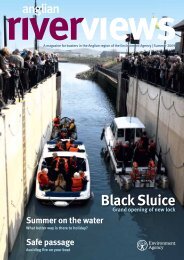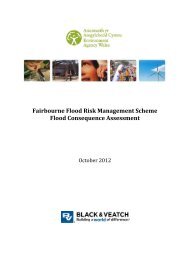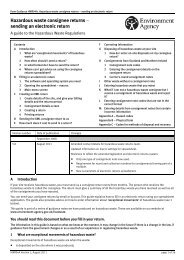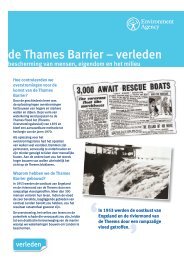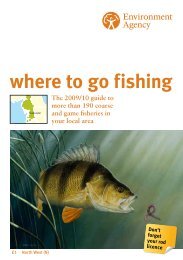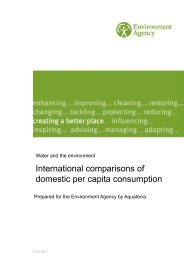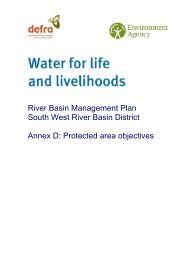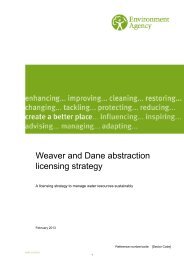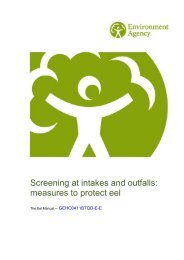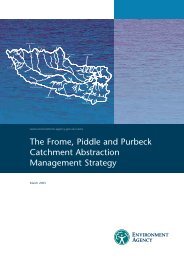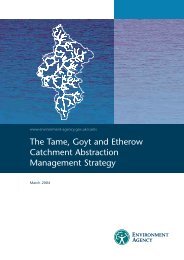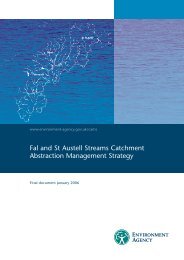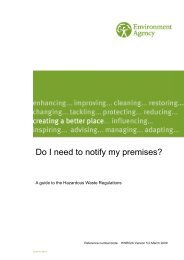Pembrokeshire and Ceredigion Rivers Catchment Flood ...
Pembrokeshire and Ceredigion Rivers Catchment Flood ...
Pembrokeshire and Ceredigion Rivers Catchment Flood ...
You also want an ePaper? Increase the reach of your titles
YUMPU automatically turns print PDFs into web optimized ePapers that Google loves.
Current <strong>and</strong> future flood risk<br />
Overview of the current flood risk What is at risk?<br />
<strong>Flood</strong> risk is the combination of<br />
two components; the likelihood<br />
(or probability) of a particular<br />
flood event occurring <strong>and</strong> the<br />
consequence (or impact) that<br />
the flood event would have if<br />
it occurred.<br />
The probability of a flood event<br />
is the likelihood of a flood of that<br />
size occurring within a one year<br />
period. It is described as an annual<br />
exceedance probability (AEP) <strong>and</strong><br />
is expressed as a percentage.<br />
For example, a 1% AEP flood<br />
event has a one per cent chance<br />
or 0.01 probability of occurring<br />
in any one year.<br />
Unless otherwise stated, numbers<br />
in this report are based on the 1%<br />
AEP river flood event. More extreme<br />
events can occur at any time. The<br />
likelihood of an extreme event<br />
occurring is small, although the<br />
consequences are potentially very<br />
serious, particularly where defences<br />
could be overtopped.<br />
In the past, many of the catchments<br />
have experienced flooding.<br />
Notable flood events occurred in<br />
1987, 1993, 1997, 2000, 2003<br />
<strong>and</strong> 2005. Areas affected include<br />
Haverfordwest, Tenby, Narberth,<br />
Ll<strong>and</strong>ysul, Llechryd <strong>and</strong> many<br />
other towns <strong>and</strong> villages across<br />
<strong>Pembrokeshire</strong> <strong>and</strong> <strong>Ceredigion</strong>.<br />
The sources of flood risk are:<br />
• river flooding is the dominant<br />
source in the CFMP area.<br />
Haverfordwest is at greatest<br />
risk, along with many towns<br />
<strong>and</strong> villages on the River Teifi<br />
including Llechryd, Lampeter,<br />
Ll<strong>and</strong>ysul, Newcastle Emlyn,<br />
Pontrhydfendigaid <strong>and</strong> Tregaron;<br />
• tidally influenced flooding<br />
occurs at the downstream end<br />
of the river catchments <strong>and</strong><br />
affects many coastal towns <strong>and</strong><br />
villages in <strong>Pembrokeshire</strong> <strong>and</strong><br />
<strong>Ceredigion</strong>, such as Aberystwyth,<br />
Haverfordwest, Llanrhystud,<br />
Cardigan, <strong>and</strong> Aberaeron;<br />
• surface water flooding is difficult<br />
to quantify as many incidents<br />
are masked by the impact of river<br />
flooding but it is believed to be<br />
a problem in some areas, for<br />
example Aberystwyth, Aberaeron,<br />
Cardigan <strong>and</strong> Haverfordwest.<br />
Surface water flooding poses a<br />
low risk of loss to life but can be<br />
a significant contributing factor<br />
to flooding;<br />
• sewer flooding is caused by<br />
overloading of sewerage systems<br />
<strong>and</strong> is a risk in Newcastle Emlyn,<br />
Cardigan, Llanybydder, Lampeter<br />
<strong>and</strong> Haverfordwest;<br />
• groundwater flooding is not well<br />
documented in the CFMP area.<br />
The village of Ludchurch is the<br />
only area identified as being<br />
potentially affected.<br />
6 Environment Agency Wales <strong>Pembrokeshire</strong> <strong>and</strong> <strong>Ceredigion</strong> <strong>Rivers</strong> <strong>Catchment</strong> <strong>Flood</strong> Management Plan<br />
CFMPs assess how flood risk is likely<br />
to change in the next 100 years.<br />
They do this at a strategic level<br />
<strong>and</strong> not at a detailed, local level.<br />
We used computer models to simulate<br />
river flows <strong>and</strong> produce indicative<br />
numbers of properties, infrastructure<br />
<strong>and</strong> environmental features at risk.<br />
These models take into account the<br />
benefit of current flood defences.<br />
Where applicable, tidal influences on<br />
river flows have also been modelled.<br />
Where models are not available we<br />
have based our flood risk estimates<br />
on our <strong>Flood</strong> Maps, which do not<br />
include flood defences. Numbers<br />
produced are sufficient for the<br />
purposes of the CFMP only.<br />
There are currently approximately<br />
1,100 properties across the CFMP<br />
area at risk from flooding during<br />
a 1% AEP flood event.<br />
<strong>Flood</strong>ing has an impact on<br />
infrastructure, including: roads <strong>and</strong><br />
railways, water <strong>and</strong> sewage treatment<br />
works <strong>and</strong> electricity sub-stations.<br />
The CFMP area has a rich <strong>and</strong> varied<br />
environmental resource. There are<br />
22 internationally designated sites<br />
either fully or partially within the<br />
1% AEP flood outline; 74 nationally<br />
designated sites, including 9 sites<br />
of special scientific interest; <strong>and</strong><br />
16 scheduled monuments,<br />
including bridges <strong>and</strong> roman<br />
remains. Around 85 km 2 of<br />
agricultural l<strong>and</strong> is also at risk from<br />
a 1% AEP flood, a large proportion<br />
of this is in the Teifi catchment.



